Rocket
A rocket is a machine which ejects mass for generating velocity.
A rocket gains velocity by ejecting mass through a rocket engine. The concept is plain conservation of impulse (or Newtons third law). Every second, the rocket ejects propellant mass through the nozzle of the rocket engine. The impulse of this mass is compensated with the remaining rocket accelerating. The more mass getting ejected (This property is called mass flow) or the faster this mass gets ejected (called average exhaust velocity or specific impulse), the more velocity the rocket gains.
The primary way to accelerate the exhaust is to use chemical energy: The propellants get combusted at high pressures inside the engine to generate heat. A rocket is thus also often called a "controlled explosion". And a typical rocket is because of that, almost only propellant tanks and rocket engines.
Rocket engines have usually so called convergent-divergent nozzles: A small throat area followed by a bell-shaped or cone shape nozzle extension. The nozzle is one of the most critical parts of a rocket, as it has the job to accelerate the exhaust. The shape of the nozzle depends on the many parameters, of which for most fantasy rockets only two relations might be interesting:
- The higher the chamber pressure a rocket engine, the smaller can be the nozzle for the same thrust.
- The ratio of the throat area and the exit area of the nozzle (the so called expansion ratio) depends on the ambient pressure (for example sea level or vacuum). The smaller the expansion ratio, the lower is the effect of ambient pressure, meaning the rocket engine is more effective on lower altitudes. That's why boosters usually have short nozzles and upper stages which operate in vacuum, even get moving extensions to make the nozzles longer.

